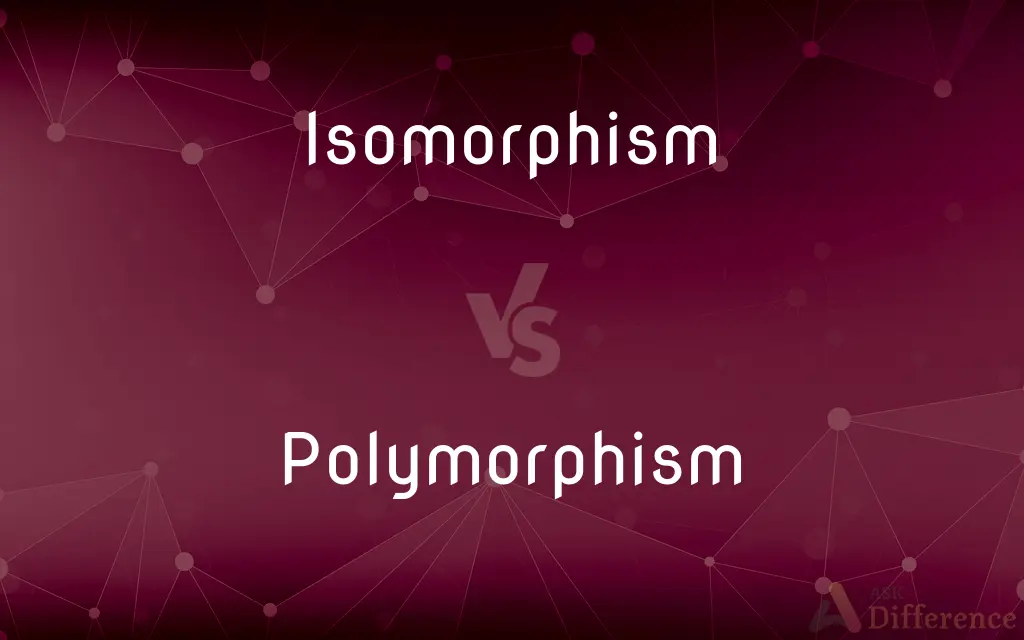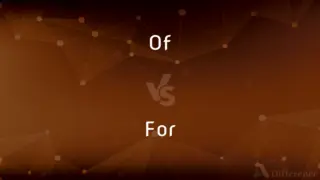Isomorphism vs. Polymorphism — What's the Difference?
By Fiza Rafique & Urooj Arif — Updated on March 13, 2024
Isomorphism refers to the equivalence of two structures in form, whereas polymorphism describes the ability of an object to take on many forms.

Difference Between Isomorphism and Polymorphism
Table of Contents
ADVERTISEMENT
Key Differences
Isomorphism is a concept found in mathematics and computer science, indicating a relationship where two structures are similar in form or function, allowing for one to be replaced by the other without loss of information. This concept is crucial in areas such as graph theory, where isomorphic graphs represent the same structure in different forms. Polymorphism, on the other hand, is a principle in programming that allows objects to be treated as instances of their parent class rather than their actual class. This enables a single interface to control access to a wide range of object types.
In the context of software development, isomorphism might refer to isomorphic algorithms that can run both on client and server sides, facilitating a seamless transition of tasks and logic across different computing environments. Whereas polymorphism is often leveraged in object-oriented programming to enhance flexibility and reusability by allowing methods to do different things based on the object it is acting upon, even though they share the same interface.
Isomorphism emphasizes structural or functional similarity without a change in essence. For example, in abstract algebra, two groups are considered isomorphic if their structures are the same, meaning there's a one-to-one correspondence between their elements that preserves operations. Polymorphism, in contrast, focuses on the capability of different objects to respond differently to the same method call, such as in Java or C++, where the same method name can perform different functions depending on the object that invokes it.
The value of isomorphism lies in its ability to prove the equivalence of different structures, providing a powerful tool for abstraction and simplification in mathematical proofs and algorithm design. Polymorphism's value is in software design, where it supports the development of more generic and modular code, allowing for easier maintenance and extension of systems.
Isomorphism and polymorphism, while different in concept and application, both play significant roles in their respective domains. Isomorphism provides a foundational basis for identifying and proving the equivalence of structures, making it indispensable in theoretical explorations and practical applications alike. Polymorphism, by enabling multiple forms of behavior through a single interface, fosters code reuse and design flexibility, key components of efficient and effective software development.
ADVERTISEMENT
Comparison Chart
Definition
Equivalence of form or structure in different entities
Ability of an object to take on many forms
Primary Domain
Mathematics and computer science
Object-oriented programming
Key Benefit
Simplifies and abstracts complex structures
Enhances flexibility and reusability of code
Example Application
Graph theory, abstract algebra
Method overloading and overriding in OOP
Underlying Principle
Structural or functional similarity without change
Multiple behaviors through a single interface
Compare with Definitions
Isomorphism
The principle of maintaining equivalence of form or function across different domains.
Isomorphic algorithms can execute both on the server and the client side.
Polymorphism
A feature that allows objects to be processed differently based on their data type or class.
Polymorphism in Java enables a method to perform different tasks based on the object that invokes it.
Isomorphism
A term used in abstract algebra to describe the similarity between two algebraic structures.
The isomorphism of two rings suggests a deep structural similarity that preserves the operations.
Polymorphism
A principle in object-oriented programming that enables multiple implementations of a method within a class hierarchy.
Through polymorphism, a single interface can represent different underlying forms of data.
Isomorphism
A relationship between two structures that shows a one-to-one correspondence.
The isomorphism between two graphs allows them to represent the same network.
Polymorphism
The capability of a single symbol or function to represent multiple types.
In polymorphism, the + operator can represent both addition and concatenation.
Isomorphism
A concept in theoretical computer science indicating similarity in computation or logic.
The isomorphism between two data structures enables interchangeable use without altering the logic.
Polymorphism
The concept of allowing methods to do different things based on the object it is acting upon.
Polymorphism enhances code flexibility by enabling dynamic method dispatch.
Isomorphism
In mathematics, a property that denotes two structures as essentially identical.
The groups G and H are isomorphic, implying a fundamental similarity in their operations.
Polymorphism
The ability in programming for different classes to respond to the same function call.
Polymorphism allows objects of different classes to be treated as objects of a common superclass.
Isomorphism
In mathematics, an isomorphism is a structure-preserving mapping between two structures of the same type that can be reversed by an inverse mapping. Two mathematical structures are isomorphic if an isomorphism exists between them.
Polymorphism
(Biology) The occurrence of more than one form, as several alleles of a particular gene or winged and wingless forms of the same species.
Isomorphism
(Biology) Similarity in form, as in organisms of different ancestry.
Polymorphism
(Chemistry) Crystallization of a compound in at least two distinct forms. Also called pleomorphism.
Isomorphism
(Mathematics) A one-to-one correspondence between the elements of two sets such that the result of an operation on elements of one set corresponds to the result of the analogous operation on their images in the other set.
Polymorphism
The ability to assume different forms or shapes.
Isomorphism
A close similarity in the crystalline structure of two or more substances of similar chemical composition.
Polymorphism
(object-oriented programming) The feature pertaining to the dynamic treatment of data elements based on their type, allowing for an instance of a method to have several definitions. en
Isomorphism
Similarity of form
Polymorphism
The property of certain typed formal systems of allowing for the use of type variables and binders/quantifiers over those type variables; likewise, the property of certain expressions (within such typed formal systems) of making use of at least one such typed variable.
Isomorphism
(biology) the similarity in form of organisms, which may be due to convergent evolution or shared genetic background, e.g. an algae species in which the haploid and diploid life stages are indistinguishable based on morphology.
Polymorphism
(crystallography) The ability of a solid material to exist in more than one form or crystal structure; pleomorphism.
Isomorphism
(chemistry) the similarity in the crystal structures of similar chemical compounds
Polymorphism
(genetics) The regular existence of two or more different genotypes within a given species or population; also, variability of amino acid sequences within a gene's protein.
Isomorphism
(sociology) the similarity in the structure or processes of different organizations
Polymorphism
Same as Pleomorphism.
Isomorphism
A one-to-one correspondence
Polymorphism
The capability of assuming different forms; the capability of widely varying in form.
Isomorphism
(group algebra) A bijection f such that both f and its inverse f −1 are homomorphisms, that is, structure-preserving mappings. Category:en:Functions
Polymorphism
(chemistry) the existence of different kinds of crystal of the same chemical compound
Isomorphism
(computer science) a one-to-one correspondence between all the elements of two sets, e.g. the instances of two classes, or the records in two datasets
Isomorphism
(category theory) A morphism which has a two-sided inverse; the composition of the morphism and such an inverse yields either one of two identity morphisms (depending on the order of composition).
Isomorphism
A similarity of crystalline form between substances of similar composition, as between the sulphates of barium (BaSO4) and strontium (SrSO4). It is sometimes extended to include similarity of form between substances of unlike composition, which is more properly called homœomorphism.
Isomorphism
A one-to-one mapping of one set onto another set which preserves the relations between the elements of the domains of the sets.
Isomorphism
(biology) similarity or identity of form or shape or structure
Common Curiosities
What is polymorphism?
Polymorphism is a programming concept where an object can take on many forms, enabling a single interface to control access to a wide range of object types.
How does isomorphism differ from polymorphism?
Isomorphism focuses on structural or functional equivalence, whereas polymorphism deals with the ability of objects to exhibit multiple forms of behavior through a single interface.
Where is isomorphism primarily used?
Isomorphism is used in mathematics and theoretical computer science to demonstrate equivalence between structures, such as in graph theory and abstract algebra.
Can you give an example of isomorphism?
An example of isomorphism is the equivalence between two algebraic structures, such as two graphs that represent the same network through different layouts.
How does isomorphism benefit mathematical proofs?
Isomorphism simplifies mathematical proofs by demonstrating that two structures can be considered equivalent, thereby reducing complexity in demonstrating properties or solving problems.
Where is polymorphism primarily used?
Polymorphism is a fundamental concept in object-oriented programming, enhancing code flexibility and reusability by allowing methods to perform different functions based on the object context.
Is isomorphism applicable in programming?
Yes, isomorphism applies in programming, especially in the context of algorithms and data structures that can be used interchangeably across different computing environments.
What is isomorphism?
Isomorphism is the equivalence in form or structure between two entities, allowing them to be interchangeable without loss of information.
How do isomorphism and polymorphism improve code quality?
Isomorphism contributes to code quality by ensuring that different structures can be used interchangeably without loss of functionality, whereas polymorphism improves code quality by increasing its flexibility, reusability, and maintainability.
Why is isomorphism important?
Isomorphism is important because it allows for the abstraction and simplification of complex structures, making them easier to understand and work with.
Can you give an example of polymorphism?
An example of polymorphism is a method in a programming language that can process objects differently depending on their class or data type, like an overridden method in a subclass.
Why is polymorphism important?
Polymorphism is important in programming because it enables the design of flexible and easily maintainable code by allowing objects of different types to be handled through a single interface.
Can isomorphism and polymorphism be used together?
Yes, isomorphism and polymorphism can be used together in software development to create robust and efficient solutions by leveraging the strengths of both concepts to simplify structures and enhance code flexibility.
How does polymorphism benefit software development?
Polymorphism benefits software development by allowing for the creation of more generic and modular code, facilitating easier updates and extensions to systems.
Is polymorphism only relevant in object-oriented programming?
While polymorphism is most commonly associated with object-oriented programming, the concept can also apply in functional programming languages through features like function overloading.
Share Your Discovery

Previous Comparison
Stitch vs. Tacking
Next Comparison
Of vs. ForAuthor Spotlight
Written by
Fiza RafiqueFiza Rafique is a skilled content writer at AskDifference.com, where she meticulously refines and enhances written pieces. Drawing from her vast editorial expertise, Fiza ensures clarity, accuracy, and precision in every article. Passionate about language, she continually seeks to elevate the quality of content for readers worldwide.
Co-written by
Urooj ArifUrooj is a skilled content writer at Ask Difference, known for her exceptional ability to simplify complex topics into engaging and informative content. With a passion for research and a flair for clear, concise writing, she consistently delivers articles that resonate with our diverse audience.
















































